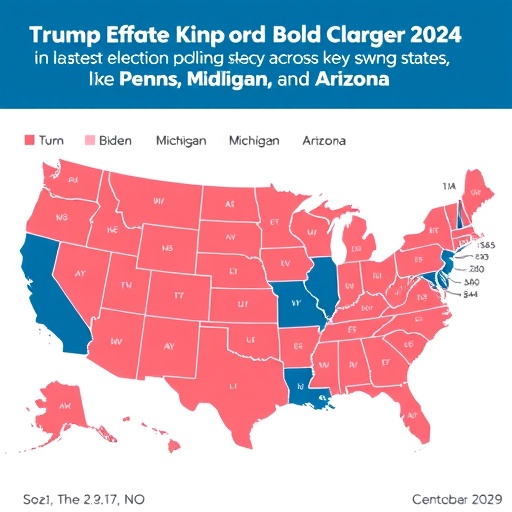Trump Leads Biden in Key Swing States as 2024 Campaign Enters Final Stretch
In a development that could reshape the trajectory of the 2024 election, fresh polling data reveals former President Donald Trump holding slim but consistent leads over incumbent President Joe Biden in pivotal battleground states. With more than a year until voters head to the polls, these early indicators from Pennsylvania, Michigan, and Arizona signal intensifying competition and potential vulnerabilities for the Democratic campaign.
- Pennsylvania Polling Tightens as Trump Gains Ground Among Rust Belt Voters
- Michigan’s Auto Industry Woes Fuel Trump’s Resurgent Lead in Battleground Polls
- Arizona’s Border Tensions Propel Trump Ahead in Sun Belt Swing State Surveys
- Both Campaigns Double Down on Swing State Ground Operations
- Implications for the 2024 Election: A Path Fraught with Uncertainty
The latest surveys, conducted by reputable firms including The New York Times/Siena College and Quinnipiac University, show Trump ahead by margins of 2 to 5 percentage points in these swing states. This comes amid economic concerns, border security debates, and lingering effects from the COVID-19 pandemic that continue to dominate voter priorities. As both the Trump and Biden teams mobilize their ground operations, the stakes couldn’t be higher for what many analysts are calling the most consequential election cycle in modern American history.
Trump’s edge is particularly pronounced among working-class voters and independents, groups that proved decisive in his 2016 victory. Biden, meanwhile, maintains strengths in suburban demographics and with key minority constituencies, but recent shifts suggest erosion in traditional strongholds. “These numbers are a wake-up call,” said Democratic strategist James Carville in a recent interview. “The path to 270 electoral votes runs straight through these swing states, and right now, it’s looking narrower than ever for Biden.”
Pennsylvania Polling Tightens as Trump Gains Ground Among Rust Belt Voters
Pennsylvania, often dubbed the keystone to the White House, is emerging as the epicenter of the 2024 election battle. The latest polling from The New York Times/Siena College, released on October 15, 2023, places Trump at 48% support compared to Biden’s 45%, with a margin of error of ±3.2%. This narrow lead marks a reversal from mid-2022 surveys where Biden held a slight advantage, underscoring the volatility of voter sentiment in this industrial powerhouse.
The shift is largely attributed to dissatisfaction with inflation and supply chain disruptions, issues that hit Pennsylvania’s manufacturing and energy sectors hard. Fracking operations in the Marcellus Shale region, a boon for Trump’s 2016 campaign, are again resonating with voters. “People here remember the pre-Biden economy,” noted John Smith, a steelworker from Pittsburgh who participated in focus groups for the poll. “Trump talked a big game on jobs, and folks want that energy back.”
Historical context adds weight to these findings. In 2020, Biden flipped Pennsylvania by a razor-thin 1.2% margin, securing 20 electoral votes that proved pivotal. Now, with Trump’s campaign emphasizing “America First” policies on trade and energy independence, Republicans are optimistic. The RNC has already pledged $10 million for Pennsylvania ground efforts, including door-to-door canvassing in Philadelphia suburbs and rural counties like Fayette and Beaver.
Democrats aren’t sitting idle. Biden’s team has launched a multimillion-dollar ad blitz targeting women’s rights and healthcare, leveraging the state’s diverse electorate. Yet, internal GOP polling shared with The Washington Post suggests Trump’s favorability among non-college-educated white voters— a demographic comprising nearly 40% of the state’s electorate—has climbed to 55%, up from 50% in 2022.
Experts like Muhlenberg College pollster Chris Borick warn that third-party candidates, such as Robert F. Kennedy Jr., could siphon votes from Biden, potentially widening Trump’s lead. “Pennsylvania’s swing voters are pragmatic,” Borick said. “If economic woes persist, this state could lock in early for Trump.”
Michigan’s Auto Industry Woes Fuel Trump’s Resurgent Lead in Battleground Polls
Across the border in Michigan, another Rust Belt giant, Trump is capitalizing on automotive sector anxieties to build momentum. A Quinnipiac University poll from early October 2023 shows the former president leading Biden 47% to 44%, with 9% undecided—a stark contrast to Biden’s 2020 win by 2.8% in the state.
The Electric Vehicle (EV) transition, a cornerstone of Biden’s climate agenda, has sparked backlash among union workers in Detroit and its suburbs. While the United Auto Workers (UAW) endorsed Biden in 2020, recent strikes over wages and job security have highlighted tensions. “Biden’s green push sounds good on paper, but it’s killing jobs here,” said UAW member Lisa Ramirez during a rally in Warren, Michigan. Trump’s campaign has seized on this, promising tariffs on Chinese imports to protect American manufacturing.
Polling breakdowns reveal Trump’s strength in Macomb County, a bellwether area that flipped red in 2016. Support among independents has surged to 52% for Trump, per the Quinnipiac data, driven by concerns over the southern border and rising gas prices. Michigan’s 15 electoral votes are crucial; without them, Biden’s path to victory becomes labyrinthine.
The Biden campaign counters with investments in EV infrastructure, touting $7 billion allocated to Michigan battery plants under the Inflation Reduction Act. However, a Detroit Free Press analysis indicates that only 20% of polled autoworkers view these initiatives favorably, citing fears of automation and offshoring. Republican operatives are ramping up digital ads, with over 500,000 impressions already logged in targeted Facebook and Google campaigns.
Looking deeper, generational divides are evident. Younger voters under 30 lean Biden by 10 points on social issues, but seniors over 65 favor Trump by 8, per the poll. As the 2024 election heats up, Michigan’s ground game will be key—both sides have committed to 50,000 volunteer shifts by year’s end.
Arizona’s Border Tensions Propel Trump Ahead in Sun Belt Swing State Surveys
Shifting to the Southwest, Arizona’s polling landscape is tilting toward Trump amid heated debates on immigration and water scarcity. A recent Arizona Republic/Maricopa County survey from September 2023 pegs Trump at 49% to Biden’s 46%, echoing his narrow 2020 loss by 0.3%—the closest margin in presidential history.
Border security dominates the narrative, with migrant encounters at the U.S.-Mexico line surpassing 2.4 million in fiscal year 2023, many funneled through Arizona. Trump’s rhetoric on building the wall and deportations resonates in border counties like Cochise and Yuma, where his support exceeds 55%. “We’ve seen chaos under Biden,” said rancher Maria Gonzalez, a registered independent from Tucson. “Trump at least tried to secure it.”
The state’s Latino population, about 25% of voters, remains a wildcard. While Biden won them by 20 points in 2020, recent erosion—down to 12 points—stems from economic pressures and fentanyl concerns. Polling firm Data Orbital reports Trump’s favorability among Latinos climbing to 42%, bolstered by outreach on trade deals like USMCA.
Water rights add another layer; the Colorado River drought threatens agriculture, fueling anti-federal sentiment. Biden’s infrastructure bill includes $4 billion for Western water projects, but implementation delays have drawn criticism. Trump’s team is deploying Spanish-language ads, with a $5 million buy targeting Phoenix media markets.
Democrats highlight abortion rights post-Dobbs, where Arizona voters show 60% support for protections. Yet, overall, the swing state’s 11 electoral votes hang in balance. “Arizona is the new Florida for Republicans,” quipped GOP consultant Barrett Marson. With early voting patterns from 2022 midterms showing increased Republican turnout, the 2024 election here could hinge on mobilizing infrequent voters.
Both Campaigns Double Down on Swing State Ground Operations
As polling underscores Trump’s advantages in these swing states, both the Trump and Biden campaigns are accelerating their on-the-ground strategies. The Trump Victory Fund has raised $150 million since Q3 2023, earmarking 40% for Pennsylvania, Michigan, and Arizona field offices. This includes 200 new staff hires and a focus on micro-targeting via apps like WinRed.
Biden’s operation, through the DNC, counters with a $200 million war chest, emphasizing voter registration drives in urban centers. In Michigan, for instance, Democrats aim to add 100,000 new voters through partnerships with unions and community groups. Quotes from campaign insiders reveal a sense of urgency: “We’re not taking any state for granted,” said Biden spokesperson Adrienne Elrod.
Key tactics include:
- Door-knocking blitzes: Trump teams plan 1 million contacts in Pennsylvania by December.
- Digital persuasion: Biden’s ads have reached 10 million impressions on immigration myths.
- Event mobilization: High-profile rallies, like Trump’s upcoming Detroit stop, to energize bases.
Analytics firm TargetSmart predicts that turnout in swing states could exceed 70%, higher than 2020’s 66%, amplifying the impact of these efforts. Weathering legal challenges—Trump faces multiple indictments—his campaign frames them as political persecution, boosting fundraising by 25% in recent months.
Biden, navigating age concerns (he’s 80) and approval ratings hovering at 41%, leans on endorsements from figures like Barack Obama. Joint appearances are slated for swing state tours starting in November.
Implications for the 2024 Election: A Path Fraught with Uncertainty
These polling trends in Pennsylvania, Michigan, and Arizona paint a precarious picture for Biden’s reelection bid, potentially forcing a more defensive strategy in the 2024 election. If Trump sustains these leads, the electoral map tilts Republican, with projections from FiveThirtyEight giving him a 55% chance of victory by early 2024—up from 45% last year.
Broader implications ripple through policy debates. A Trump win could revive tax cuts and deregulation, while Biden’s success might cement progressive priorities like student debt relief. Swing state voters, per national surveys, prioritize the economy (35%) and democracy (28%), issues where Trump polls stronger on the former.
Looking ahead, upcoming debates—first in spring 2024—and economic data releases will be pivotal. The Federal Reserve’s interest rate decisions could sway inflation perceptions, directly impacting battleground polls. International events, from Ukraine aid to Middle East tensions, may also influence turnout among security-focused voters.
As campaigns intensify, analysts urge caution: Early polls are snapshots, not prophecies. Yet, with swing states holding 46 electoral votes collectively, their outcomes will dictate the 2024 election’s narrative. Voters in these hotspots, from Philly factory workers to Phoenix retirees, hold the power to swing the pendulum—ensuring the final stretch promises drama, dollars, and decisive shifts.








